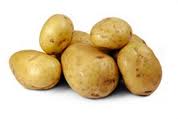Wally Richards – the Psyllid pest: enemy of the home gardener
Now days our new season potato plants face an even bigger danger than frost – the potato psyllid.
This new pest can cause total loss of crops in many areas. One key factor is that a very early crop of fairly quick manuring potatoes will suffer only minor damage in most gardens. Later in the season when the pest numbers increase, which makes it is more difficult to control, there is a noticeable increase in damage and crop failure.
 Potato crops planted say in November or December will need a lot of protection to produce good spuds for storage.
Potato crops planted say in November or December will need a lot of protection to produce good spuds for storage.
In the worst affected areas of New Zealand plantings in October will also need ample protection.
MAF New Zealand has published some information on their website as follows:
- What does the tomato/potato psyllid look like?
The adult tomato/potato psyllid is about the size of an adult aphid but looks like a tiny cicada under magnification. The female lays yellow eggs that are attached by stalks to plant leaves, usually to the leaf edges. Psyllid nymphs hatch from these eggs and after five moults become adults. The nymphs are flat scale-like insects which are mostly inactive but move when disturbed. Nymphs and adults feed by sucking plant juices, which is how they are thought to spread
Liberibacter (the toxin that does the damage).
Nymphs and adults secrete plant sap as white granules called ‘psyllid sugars’ which can be seen on the leaves. In humid conditions and where there are large numbers of psyllids, black sooty mould fungi can grow on the sugars. Dense sooty mould on leaves may reduce photosynthesis, but this is rarely a problem on outdoor plants as the psyllid sugars are usually removed by wind and rain.
- How will the tomato/potato psyllid/Liberibacter affect my plants?
On tomato the symptoms of psyllid yellows are the yellowing and stunting of the growing tip and a cupping or curling of the leaves. Many flowers may fall off the trusses of infected plants and fruit may be small and mis-shaped.
On potato, psyllid yellows disease causes a stunting and yellowing of the growing tip, and the edges of the curled leaves often have a pink blush.
The stem may have swollen nodes and show a browning of the vascular tissue. After a while, infected potatoes develop a scorched appearance and plants collapse prematurely. Potato plants that are infected at an early stage develop numerous small tubers.
The tomato/potato psyllid breeds mainly on plants in the Solanaceae (potato and tomato family), but can also attack some species of Convolvulaceae (kumara and bindweed family).
Other host plants of the tomato/potato psyllid include Apple of Peru, capsicum, chilli, egg plant, kumara, poroporo, tamarillo, pepino and thornapple.
- Why is the tomato/potato psyllid a problem?
Tomato/potato psyllid adults and nymphs cause damage to host plants through feeding on leaves and by transmitting a bacterial pathogen, Liberibacter, that lives in plants. The bacterium is believed to cause diseases such as ‘psyllid yellows’ in tomatoes and potatoes, and ‘zebra chip’ symptoms in potato tubers. These diseases can drastically reduce the quality and yield of your crop.
So the problem is greater than just protecting your tomatoes and potatoes as you are likely to have other plants and weeds growing that will also host the pests which means they will re-infest your crops which will require continued protection.
It also answers another question for my garden last summer as my tamarillo produced a very poor crop, capsicums and chilli were also poorer than usual. A number of gardeners will likely have convolvulus growing on their land or nearby and this common weed is also a host.
A plant not mentioned but of the same family as tomatoes is pepinos and my pepino plants were also poor producers this last season. What to do?
My advice has been to place Neem Tree Granules in the planting hole of all crops affected by the psyllid. With potatoes a further sprinkling as a side dressing once mounding up is completed. With other crops a side dressing after planting out and this repeated at 6 -8 week periods.
Sprays with Neem Tree Oil and Key Pyrethrum applied on a regular program starting at say once a month early season and increasing to about 7-10 days later in the season. Spraying late afternoon ensuring coverage of undersides of leaves. Spraying should involve all host plants of the pest including weeds as mentioned unless these are removed safely.
The winged adult psyllid has been reported to be able to fly for 1524 miles so re-infestation from other gardens nearby will be a ongoing problem. The female laying 510 eggs in a 21 day period is another reason for good controls.
The yellow sticky cards available to home gardeners should be employed near the tops of growing plants and in doorways and ventilation entrances of glasshouses. The cards catch adults flying into a crop and that also helps to keep population levels low. It has been found with tomatoes that if an effected plant is cleared of he pest then new fruits will be normal. This is a little late for potatoes that have formed when plant is infected.
The psyllid is a much bigger problem for the home gardener than previously thought.


Is this aproved for Potatoes and Tomatoes